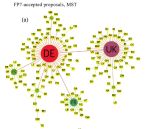EPJ B Highlight - Winner and losers of the EU funding challenge
- Details
- Published on 10 December 2014

Successfully attracting EU funding could depend on the nature of the research consortium
The European Union has a well-oiled funding mechanism in the form of grants given to research consortia. These are essentially made up of collaborating academic and industry-based research organisations. Understanding which type of consortium work receives funding could help future applicants. And it could also bring further transparency on how public funds are spent. Now, Maria Tsouchnika and Panos Argyrakis from the University of Thessaloniki, Greece, have brought valuable insights into the structure of research consortia that are most likely to attract EU funding, in a paper published in EPJ B.To do so, the authors analysed large numbers of both successful and unsuccessful consortia from the 7th Framework Programme, which ran for six years until 2013. The authors considered the consortia as networks of research entities (the network nodes) that worked together (such collaborations are the links between the network nodes). Unlike previous studies, the authors decided to focus on both rejected and accepted proposals to detect differences between the two.
Tsouchnika and Argyrakis found that a proposal from a partnership made up of small-scale institutes is more likely to be rejected. The remedy, they suggest, would be the inclusion of one or more large-scale institutes.
The authors also found that large-scale institutes favour collaborations with small-scale ones, in both successful and unsuccessful research consortia. This means they are different from other social networks of similar interactions. There, nodes tend to associate with nodes of similar linking levels.
Finally, the team also revealed that in both network types the same five countries are the most influential ones: France, Germany, the UK, Spain and Italy. This success rate does not, however, reflect the fact that their relative importance in the two network types is not the same.
M. Tsouchnika and P. Argyrakisis (2014), Network of participants in European Research: accepted vs. rejected proposals, European Physical Journal B, DOI: 10.1140/epjb/e2014-50450-4




